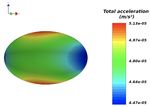IAA-PDC-21-0X-XX 7th IAA Planetary Defense Conference - PDC 2021 26-30 April 2021, Vienna, Austria
←
→
Page content transcription
If your browser does not render page correctly, please read the page content below
7th 1
IAA Planetary Defense Conference – PDC 2021
26-30 April 2021, Vienna, Austria
IAA-PDC-21-0X-XX
Surface Gravimetry on Dimorphos with GRASS on Juventas
Birgit Ritter(1), Özgür Karatekin(1), Jose A. Carrasco(2), Matthias Noeker(1,3), Ertan
Ümit(1), Emiel Van Ransbeek(4), Higinio Alaves(2), Elisa Tasev(1), Marta Goli(1),
and Michel Van Ruymbeke(1)
(1)
Royal Observatory of Belgium, Avenue Circulaire 3, 1180 Brussels, Belgium,
birgit.ritter@observatory.be
(2)
EMXYS, Elche/Elx, Spain
(3)
Université catholique de Louvain, Louvain-la-Neuve, Belgium
(4)
Royal Belgian Institute for Space Aeronomy, Brussels, Belgium
Keywords: Gravimeter, surface acceleration, Dimorphos, Juventas/Hera
Introduction Hera will be launched in 2024 and arrive at Didymos in
The gravimeter for small solar system objects (GRASS) the very end of 2026. Juventas will be released mid-
[1] is an innovative and compact sensor that can 2027 to contribute to asteroid research and mitigation
measure absolute surface accelerations in the order of assessment objective of the Hera mission by using radar
nano-g. It is payload onboard the Juventas CubeSat and radio measurements. At the end of the mission,
which will land on Dimorphos, the moonlet of the binary Juventas will soft-land on Dimorphos’ surface and start
asteroid system Didymos. GRASS will measure the local with GRASS its dedicated mission phase for geophysical
gravity vector and its temporal variations at the landing investigation. The local surface acceleration vector
site in order to constrain the geological substructure as measurements will be complemented by a detailed
well as the surface geophysical environment. shape model as well as radar and radio science
The instrument is currently under development at the measurements.
Royal Observatory of Belgium in cooperation with
EMXYS in Spain and the Belgian Royal Institute of
Space Aeronomy.
The average gravitational force expected on Dimorphos’
surface is around 4.5 x 10-5 m s-2 (or 4.5 mGal). Apart
from the self-gravitation of the body, centrifugal forces
and the acceleration due to the main body of the system
contribute to the surface acceleration. The temporal
variation of the signal is driven by the dynamical state of
Didymoon with respect to Didymain and the related
librations. Figure 1 illustrates the Didymos system, with
its main body and the moonlet Dimorphos. While for the
main body a shape model exists, for Dimorphos
Figure 1: Surface gravity in the Didymos system
currently a three-axial ellipsoid is assumed (Figure 2).
Mission overview
GRASS will fly onboard the Juventas CubeSat [2], which
is part of the Hera mission [3,4]. Hera is part of the
international Asteroid Impact and Deflection Assessment
(AIDA) cooperation, consisting of ESA’s Hera and
NASA’s Double Asteroid Redirection Test (DART)
mission. DART consists of a kinetic projectile that will
impact on the secondary body of the binary asteroid
system Didymos, whereas Hera will visit the system
afterwards to investigate the aftermath of the impact and
addresses further more general scientific questions.
Figure 2: Surface gravity on Dimorphos7th 2
IAA Planetary Defense Conference – PDC 2021
26-30 April 2021, Vienna, Austria
GRASS science objectives In order to obtain the full 3-dimensional gravity vector,
GRASS focuses on the determination of the mass of two of these rotating gravimeters are required, ideally
Dimorphos, constraining the local geological aligned orthogonally to each other. Figure 4 shows the
substructure (mass anomalies, local depth and lateral two-axes gravimeter.
variations of regolith) and surface geophysical
environment (tides, dynamic slopes and centrifugal
forces) and indirectly, in synergy with other instruments,
on a global gravity solution and the interior structure of
the moonlet.
Scientifically, this is important to understand the origin
and evolution of the asteroid moonlet itself and the
binary system as a whole. Additionally, these quantities
are also relevant to characterize the kinetic impact
technique for asteroid deflection. Furthermore, GRASS
will demonstrate its abilities to be possibly employed in
other missions to small bodies, as the knowledge of Figure 4: CAD view of the two-axes gravimeter
gravitational accelerations induced by small bodies with
irregular shapes is crucial for any landing or rover
mission as well as for proximity operations. Surface operations
Table 1 gives an overview of the science objectives. A single measurement of the gravimeter lasts for several
minutes as it includes a number of slow rotations of the
Table 1: GRASS science objectives sensor head for good performance. Three different
Objective Measurement operational modes are foreseen: Health Check (HC),
S#1 Science measurement (SCI), Calibration measurement
Determination of local gravity (CAL). Addressing S#1, a single measurement of the
Local subsurface
vector at landing location with local surface acceleration vector at the landing location
inhomogeneities
accuracy of7th 3
IAA Planetary Defense Conference – PDC 2021
26-30 April 2021, Vienna, Austria
Project timeline
Acknowledgements
This project has received funding from BELSPO via the
PRODEX Programme of ESA and from the European
Union’s Horizon 2020 research and innovation program
under grant agreement Nr. 870377 NEO-MAPP.
References
[1] van Ruymbeke, M. et al., EGU2016-9313, EGU
General Assembly, Vienna, Austria, 2016.
[2] Karatekin et al., Juventas CubeSat for the Hera
mission, PDC 2021
[3] Michel et al., The ESA Hera mission: planetary
defense and science return, PDC 2021
[4] Küppers et al., The measurement goals and payload
of the Hera mission to Dimorphos, PDC 2021You can also read






















































